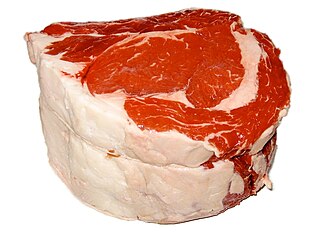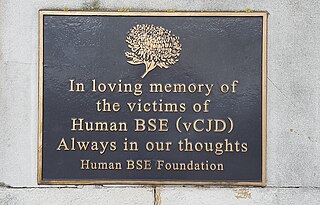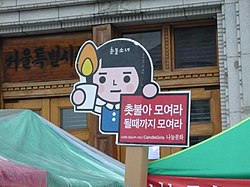
Beef is the culinary name for meat from cattle. Beef can be prepared in various ways; cuts are often used for steak, which can be cooked to varying degrees of doneness, while trimmings are often ground or minced, as found in most hamburgers. Beef contains protein, iron, and vitamin B12. Along with other kinds of red meat, high consumption is associated with an increased risk of colorectal cancer and coronary heart disease, especially when processed. Beef has a high environmental impact, being a primary driver of deforestation with the highest greenhouse gas emissions of any agricultural product.

Transmissible spongiform encephalopathies (TSEs) also known as prion diseases, are a group of progressive, incurable, and fatal conditions that are associated with prions and affect the brain and nervous system of many animals, including humans, cattle, and sheep. According to the most widespread hypothesis, they are transmitted by prions, though some other data suggest an involvement of a Spiroplasma infection. Mental and physical abilities deteriorate and many tiny holes appear in the cortex causing it to appear like a sponge when brain tissue obtained at autopsy is examined under a microscope. The disorders cause impairment of brain function, including memory changes, personality changes and problems with movement that worsen chronically.

Mechanically separated meat (MSM), mechanically recovered/reclaimed meat (MRM), or mechanically deboned meat (MDM) is a paste-like meat product produced by forcing pureed or ground beef, pork, mutton, turkey or chicken under high pressure through a sieve or similar device to separate the bone from the edible meat tissue. When poultry is used, it is sometimes called white slime as an analog to meat-additive pink slime and to meat extracted by advanced meat recovery systems, both of which are different processes. The process entails pureeing or grinding the carcass left after the manual removal of meat from the bones and then forcing the slurry through a sieve under pressure.

There are different systems of feeding cattle in animal husbandry. For pastured animals, grass is usually the forage that composes the majority of their diet. In turn, this grass-fed approach is known for producing meat with distinct flavor profiles. Cattle reared in feedlots are fed hay supplemented with grain, soy and other ingredients to increase the energy density of the feed. The debate is whether cattle should be raised on fodder primarily composed of grass or a concentrate. The issue is complicated by the political interests and confusion between labels such as "free range", "organic", or "natural". Cattle raised on a primarily foraged diet are termed grass-fed or pasture-raised; for example meat or milk may be called grass-fed beef or pasture-raised dairy. The term "pasture-raised" can lead to confusion with the term "free range", which does not describe exactly what the animals eat.

Lee Myung-bak often referred to by his initials MB, is a South Korean businessman and former politician who served as 10th president of South Korea from 2008 to 2013. Before his presidency, he was the CEO of Hyundai Engineering and Construction, and the mayor of Seoul from 2002 to 2006.

Creekstone Farms Premium Beef, LLC is an American beef processing company located in Arkansas City, Kansas.

Variant Creutzfeldt–Jakob disease (vCJD), commonly referred to as "mad cow disease" or "human mad cow disease" to distinguish it from its BSE counterpart, is a fatal type of brain disease within the transmissible spongiform encephalopathy family. Initial symptoms include psychiatric problems, behavioral changes, and painful sensations. In the later stages of the illness, patients may exhibit poor coordination, dementia and involuntary movements. The length of time between exposure and the development of symptoms is unclear, but is believed to be years to decades. Average life expectancy following the onset of symptoms is 13 months.
United States beef imports in Japan were a contentious issue in Japan–United States relations after BSE was detected in a steer in Washington. After multiple beef import restrictions in Japan, the United States and Japan struck a trade deal to lift the beef import ban in May 2019. Exports of U.S. beef to Japan totaled almost $2.4 billion in 2021.

Bovine spongiform encephalopathy (BSE), commonly known as mad cow disease, is an incurable and invariably fatal neurodegenerative disease of cattle. Symptoms include abnormal behavior, trouble walking, and weight loss. Later in the course of the disease, the cow becomes unable to function normally. There is conflicting information about the time between infection and onset of symptoms. In 2002, the World Health Organization (WHO) suggested it to be approximately four to five years. Time from onset of symptoms to death is generally weeks to months. Spread to humans is believed to result in variant Creutzfeldt–Jakob disease (vCJD). As of 2018, a total of 231 cases of vCJD had been reported globally.

Kim Gyu-ri, is a South Korean actress best known for the film Portrait of a Beauty.

Professor David Ronald Brown is an Australian-born research scientist notable for his work on prion diseases, which include bovine spongiform encephalopathy and vCJD. His most notable research relates to the metal binding of the protein central to these diseases, the prion protein, and its possible cellular role as an antioxidant.
Chojoongdong, abbreviated as CJD, is a pejorative term which refers to three highly circulated conservative newspapers in South Korea. The word is an acronym of the Chosun, Joong-ang and Dong-a Ilbo newspapers, and the grouping is seen as forming the basis of South Korea's conservative media.

Meat on the bone or bone-in meat is meat that is sold with some or all of the bones included in the cut or portion, i.e. meat that has not been filleted. The phrase "on the bone" can also be applied to specific types of meat, most commonly ham on the bone, and to fish. Meat or fish on the bone may be cooked and served with the bones still included or the bones may be removed at some stage in the preparation.
United States beef imports in South Korea made up a $504 million industry for the American beef industry in 2010. The import of U.S. beef was banned in 2003 in South Korea and in other nations after a case of bovine spongiform encephalopathy was discovered in the United States. At the time, South Korea was the third-largest purchaser of U.S. beef exports, with an estimated market value of $815 million. After a number of failed attempts at reopening the Korean market, imports finally resumed in July 2008 leading to the massive 2008 US beef protest in South Korea. In 2010, South Korea again became the world's third largest U.S. beef importer.
The status of United States beef imports has been an issue in Taiwan–United States relations. Controversy has centered on cases of bovine spongiform encephalopathy, and the use of ractopamine as an additive in feeds.

MBC TV is a South Korean free-to-air television channel and is considered the first private company in South Korea launched on 8 August 1969 and owned by Munhwa Broadcasting Corporation.
The first Korean student movement begun in 1919, when students took part in the Sam-il Movement of 1 March to call for the end of Japanese colonization. The student movement has since then played a major part in several big political changes in Korea. Before liberation of Korea from Japanese rule in 1945, the main focus of the student movement was opposing this rule and demanding Korea's independence. After 1945, the student movements were mainly concerned with righting alleged wrongs in the Korean government. Students rose for instance against the South Korea's government of Syngman Rhee after the allegedly rigged elections in March 1960. 1980 marked a turning point in the South Korean student movement. After the Gwangju massacre in May 1980, the student movement got a clear vision, based on Marxism. Student activism is still common on the 21st century South Korean political scene.

The United Kingdom was afflicted with an outbreak of Bovine spongiform encephalopathy, and its human equivalent variant Creutzfeldt–Jakob disease (vCJD), in the 1980s and 1990s. Over four million head of cattle were slaughtered in an effort to contain the outbreak, and 178 people died after contracting vCJD through eating infected beef. A political and public health crisis resulted, and British beef was banned from export to numerous countries around the world, with some bans remaining in place until as late as 2019.
In South Korea, candlelight rallies, also referred to as the Candlelight Struggle, Candlelight Revolution, or a candlelight cultural festival and is also attended with a humorous props and banner along with candles. Candlelight protests are symbolic collective gatherings of political dissent in South Korea to combat injustice peacefully. This method of protesting began in 1992 for opposing the charging of online service. After that in 2002, as a result of the Yangju highway incident, then utilized in the rallies against the impeachment of Roh Moo-hyun in 2004, re-used again in the 2008 U.S. beef protests, and emerged in the 2016-18 President Park Geun-hye protests.

The mad cow crisis is a health and socio-economic crisis characterized by the collapse of beef consumption in the 1990s, as consumers became concerned about the transmission of bovine spongiform encephalopathy (BSE) to humans through the ingestion of this type of meat.


















